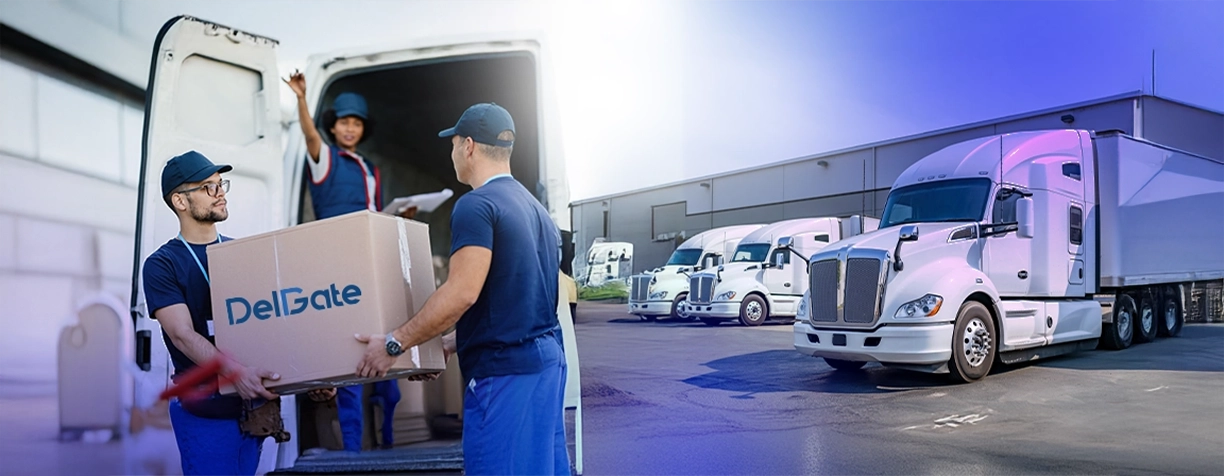In today’s fast-paced world, the ability to deliver goods quickly and efficiently is paramount. Cross-Docking Improves Last-Mile Delivery by streamlining the process, and it’s becoming an increasingly popular strategy for optimizing supply chains. This blog post will explore the benefits of cross-docking and how it can enhance last-mile delivery operations. Companies that adopt Cross-Docking Improves Last-Mile Delivery often see significant improvements in their overall logistics efficiency.
Table of Contents
What Is Cross-Docking?
Cross-Docking is a logistics technique where products are unloaded from incoming transport (trucks, trains, etc.) and immediately loaded onto outgoing transport with minimal or no storage in between. The main goal is to bypass the traditional warehousing stage, reducing handling, storage, and associated costs. By implementing Cross-Docking, businesses can significantly reduce their inventory holding costs.
Benefits of Cross-Docking

Cross-Docking offers several advantages. These include quicker delivery times, lower inventory holding costs, reduced labor expenses, and a decrease in product damage. It enables businesses to respond more rapidly to customer demand and market changes. For instance, companies like Amazon have successfully integrated Cross-Docking into their logistics, achieving faster delivery times and higher customer satisfaction.
The Impact of Cross-Docking on Last-Mile Delivery Effectiveness
The impact of Cross-Docking Improves Last-Mile Delivery effectiveness is significant. By streamlining the supply chain, it reduces the time it takes for goods to reach the end customer. The gains in efficiency directly translate into happier customers and quicker delivery times. Moreover, Cross-Docking helps in reducing the carbon footprint by minimizing the need for additional transportation and storage.
Case Study: Amazon’s Cross-Docking Strategy
Amazon is a prime example of Cross-Docking success. Their vast network of Cross-Docking facilities allows them to quickly sort and dispatch packages to distribution centers and directly to customers, enabling their famous same-day or next-day delivery. Amazon’s use of Cross-Docking Improves Last-Mile Delivery has been a key factor in their ability to provide fast and reliable shipping to their customers.
Chart: Amazon’s Delivery Time Improvement (Illustrative)
| Year | Average Delivery Time |
| 2010 | 7-10 Days |
| 2015 | 3-5 Days |
| 2020 | 1-2 Days |
| 2023 | Same-Day/Next-Day (Select Locations) |
Ways Cross-Docking Boosts Last-Mile Delivery Performance
Cross-Docking Improves Last-Mile Delivery performance by optimizing the flow of goods. This method minimizes delays and reduces the number of touchpoints in the supply chain. It also allows for better resource allocation and management. For companies operating in Canada 3PL logistics, adopting Cross-Docking can be particularly beneficial due to the country’s vast geography and diverse consumer market.
Example: Grocery Delivery Services
Grocery delivery services frequently use Cross-Docking to manage fresh produce and perishable items. Incoming shipments are quickly sorted and routed to delivery vehicles for timely delivery to consumers. This approach ensures that products remain fresh and are delivered to customers in the shortest possible time, highlighting the effectiveness of Cross-Docking in the grocery sector.
Cross-Docking in Canada

Cross-Docking in Canada is becoming increasingly important as e-commerce continues to grow. Canadian businesses are recognizing the benefits of Cross-Docking to meet consumer demands for faster shipping. This allows for efficient distribution across the vast Canadian landscape. Companies offering fastest shipping in Canada often utilize Cross-Docking to achieve their delivery goals.
Case Study: Canadian Tire
Canadian Tire uses Cross-Docking to distribute products from its distribution centers across its network of retail stores, optimizing inventory management and ensuring timely delivery to its customers. By leveraging Cross-Docking, Canadian Tire has improved its supply chain efficiency and enhanced customer satisfaction.
Cross-Docking in Vancouver
Cross-Docking in Vancouver is particularly relevant due to the city’s strategic location as a major port and transportation hub. It facilitates the efficient movement of goods into and out of the region, supporting both domestic and international trade. Companies operating in Cross-Docking in Vancouver can take advantage of the city’s infrastructure to enhance their logistics operations.
Cross-Docking in Toronto
Cross-Docking in Toronto is crucial for serving the large and diverse consumer market in the Greater Toronto Area. The region’s dense population and high demand for goods make Cross-Docking an essential part of its supply chain infrastructure. By adopting Cross-Docking, businesses in Toronto can better meet the needs of their customers.
Cross-Docking in Montreal
Cross-Docking in Montreal also plays an important role, serving both the local market and facilitating trade with the United States and Europe. The city’s bilingual population and its position as a gateway to North America further contribute to its importance in the Canadian supply chain. Companies involved in Cross-Docking in Montreal benefit from the city’s unique position to optimize their logistics.
The Role of Cross-Docking in Reducing Storage Costs
Cross-Docking Improves Last-Mile Delivery by reducing storage costs. It eliminates the need for extensive warehousing, leading to lower expenses on rent, utilities, and inventory management. The goal is to move goods as quickly as possible through the supply chain, minimizing holding times and associated costs. This aspect of Cross-Docking is especially beneficial for companies looking to reduce their operational expenses.
Data: Storage Cost Reduction (Example)
| Scenario | Traditional Warehousing Costs | Cross-Docking Costs | Savings |
| Storage for 1 Month | $10,000 | $2,000 | $8,000 |
| Storage for 3 Months | $30,000 | $6,000 | $24,000 |
| Storage for 6 Months | $60,000 | $12,000 | $48,000 |
Companies Providing Fulfillment Services:

Here are five real companies that provide fulfillment services:
- DelGate
- Canada Post
- FedEx Canada
- UPS Canada
- DHL Canada
These companies often utilize Cross-Docking Improves Last-Mile Delivery to enhance their logistics operations and provide better services to their clients.
Conclusion
Cross-Docking Improves Last-Mile Delivery operations significantly, leading to cost savings, faster delivery times, and increased customer satisfaction. Embracing this strategy can help businesses stay competitive in the rapidly evolving e-commerce landscape. As the demand for quick and reliable shipping continues to grow, the importance of Cross-Docking will only increase.





